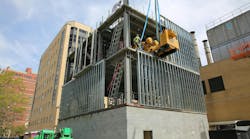Everyone enters the electrical business for different reasons. Whether they're driven by family tradition, love of the trade, dreams of research and development, or career advancement, you'll be hard pressed to find owners of engineering or contracting firms who are not interested in turning a profit. Everyone wants to make money, but what many owners don't realize is that making a profit for the sake of profit does little to motivate most employees. What does motivate most people? Reinvesting a significant portion of profits in the company is a great start. By sharing the wealth with employees, motivation remains high, and the owner will still enjoy a fair return on his investment.
By reinvesting profits in the company, you can provide the best working environment, equipment, training, compensation, and support for employees. This approach ultimately leads to producing an even better product for clients and generates repeat business. By sharing the profits with employees through incentive compensation, you motivate them to be proactive in solving business problems and producing the profits they deserve for their creative efforts.
When these strategies are implemented properly, they quickly become part of the corporate culture, resulting in a profit machine that provides not only profits, but also satisfied clients, employees, and owners. Most engineering and contracting firms are already doing the work — creating the value that deserves a reward by a 20%+ profit on net revenues. Let's take a look at how you can realize a similar potential.
Understanding the financial fundamentals
Every week, I meet design professionals that somehow managed to stay in business with little or no understanding of what it takes to consistently produce a profit. They believe that working longer hours is the only way to produce a profit and stay in business. Worse yet, many make the excuse that quality design and making a profit are inconsistent goals — a mind-set that is clearly untrue.
Although there are about a dozen key indicators worth tracking, three will give you 80% of the benefit. Every firm, without exception, should be monitoring and acting upon the following indicators on a regular basis: employee utilization rate, net multiplier, and overhead rate. Let's take a look at each more closely.
Employee utilization rate
The employee utilization rate is calculated as follows:
Direct Labor Dollars ÷ Total Labor Dollars = Utilization Percentage
A higher utilization simply means that more labor dollars are being charged to revenue-producing projects. With everything else being equal, this will result in increased revenue with no increase in costs. In other words, every dollar of revenue produced through higher employee utilization goes directly to the bottom line.
The average A/E firm achieves a utilization rate of about 61% to 62%. On the other hand, a top-performing A/E firm produces a 70% to 71% utilization rate. The increased employee utilization rate can have a dramatically positive effect on profits.
Let's do some utilization rate math for practice. If you assume the average salaried employee works 40 hours per week (and you wanted to increase their utilization by 5%), you would simply need to increase their direct labor hours by two per week. If their billing rate was $100 per hour, you would produce $200 per week of additional profit. Multiply this by 50 weeks, and this employee would produce $10,000 more of profit.
If you extrapolate this across the entire company, a 10-person firm would generate an additional $100,000 of profit. A 100-person firm would generate an additional $1,000,000 of profit. Where do you find the extra 2 hours? How about eliminating wasteful meetings and surfing the Internet, for starters.
Net multiplier
The net multiplier is calculated as follows:
Net Revenues ÷ Direct Labor Dollars = Net Multiplier
Note: There is often confusion about the term “revenue.” For the purpose of this article, it means: total company sales (all project-related expenses other than direct labor = net revenue)
A higher net multiplier simply means that more revenue is being generated for every dollar of direct labor. In other words, you are being paid more money with no increase in costs. The average A/E firm achieves around a 2.9 multiplier in direct labor. Top-performing A/E firms, on the other hand, can achieve a 3.5 multiplier or higher. The increase in net multiplier can have a dramatically positive effect on profits.
Let's assume that you have an employee that is paid $30 per hour. If that employee achieves a net multiplier of 2.9, the company will earn $87 for every hour of direct labor. If that employee achieves a 3.5 net multiplier, the company will earn $105 for every hour of direct labor.
$105 - $87 = $18 of additional profit per hour
$18 of additional profit per hour × 28 hours (assume 40 hours per week at 70% utilization) = $504 of additional profit per week
$504 of additional profit per week × 50 weeks = $25,200 of additional profit per year per employee
If you extrapolate this across the entire company, a 10-person firm would generate an additional $250,200 of profit. A 100-person firm would generate an additional $2,520,000 of profit. How do you increase the net multiplier? While it's clearly easier to do the math than to make it happen, here are few ideas to get you started.
-
Stop the unpaid scope creep. This is by far the No. 1 enemy of profit.
-
Do fixed fee work within your area of expertise. The opportunities for reuse of prior work is high.
-
Increase your hourly rates every year. Don't worry — it's extremely unlikely that you'll lose any business.
-
Quote fixed fees for additional services.
-
Avoid hourly work to a cap.
-
Do not give a fixed scope for an unknown quantity of work.
Overhead rate
The overhead rate is calculated as follows:
Total Overhead Expenses ÷ Direct Labor Dollars = Overhead Rate
The Overhead Rate is expressed as a percentage (150% of direct labor, for example).
As a rule, the lower the overhead rate the better, because it allows you to produce work at a lower cost and, in turn, be more profitable. Unfortunately, too many firms neglect the required investment in technology, supplies, and support staff under the guise of keeping the overhead rate low. At the end of the day, this is a shortsighted view of business operations. A heavy-handed approach to reducing overhead will ultimately lead to a dramatic decrease in productivity (net multiplier) and profits.
The secret of creating a profit machine does not lie in keeping your supply cabinet empty and reducing (or eliminating) employee benefits. Oddly enough, the largest component of overhead is indirect labor. If you increase your utilization rate, you reduce your overhead rate as well.
Everything else being equal, a 70% utilization rate will substantially solve your overhead problem. This is not to say, however, that you should be frivolous with overhead expenditures. Every reasonable effort should be made to keep overhead costs under control. Here are some ideas to get you started:
-
Rather than let everyone contract for their own cell phone, negotiate a company-wide cell phone plan.
-
Consolidate office supply orders to obtain discounts.
-
Make sure you track all of your project printing costs for reimbursement.
-
Sublease unneeded office space.
-
When work runs out, do not hold on to employees for too long.
Cannon is president of AEC Management Solutions, Inc., Matawan, N.J. He can be reached at [email protected].


